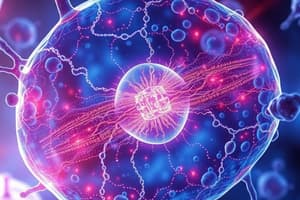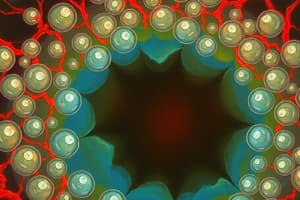Podcast
Questions and Answers
What is the study of the tissues of the body and their arrangement called?
What is the study of the tissues of the body and their arrangement called?
Histology
All living organisms are formed of cells.
All living organisms are formed of cells.
True (A)
What is the outer boundary of the cell called?
What is the outer boundary of the cell called?
- Cytoplasm
- Cell wall
- Plasma membrane (correct)
- Nucleus
The remaining part of the cell, excluding the nucleus, is called the ______.
The remaining part of the cell, excluding the nucleus, is called the ______.
What forms the basic structure of the plasma membrane?
What forms the basic structure of the plasma membrane?
Which type of proteins may embed completely or partially within the lipid bilayer?
Which type of proteins may embed completely or partially within the lipid bilayer?
What is the function of the cell coat or glycocalyx?
What is the function of the cell coat or glycocalyx?
Match the following organelles with their descriptions:
Match the following organelles with their descriptions:
What type of endoplasmic reticulum is highly basophilic due to the presence of ribosomes?
What type of endoplasmic reticulum is highly basophilic due to the presence of ribosomes?
What is the primary function of the smooth endoplasmic reticulum?
What is the primary function of the smooth endoplasmic reticulum?
Flashcards are hidden until you start studying
Study Notes
Cell Structure
- Cell is the fundamental unit of life, forming the building blocks of all living organisms.
- Despite variations in shape, size and function, cells share common features.
- Plasma membrane encloses the cell, acting as a barrier and controlling what enters and exits.
- The plasma membrane is too thin for light microscopy, but electron microscopy reveals a double dark line with a light space in between
- The nucleus lies at the center of the cell, acting as the control center.
- Cytoplasm encompasses the space between the plasma membrane and nucleus, containing structures responsible for various cellular functions.
- Organelles are structures within the cytoplasm crucial for maintaining cell life and performing specific functions.
Plasma Membrane Structure
- Phospholipids form a double layer with hydrophobic tails pointing inward and hydrophilic heads facing outward.
- Cholesterol inserts within the phospholipid bilayer.
- Integral proteins are embedded within the lipid bilayer, either fully or partially.
- Peripheral proteins associate with the inner lipid bilayer but do not penetrate it.
- Carbohydrates attach to proteins, forming glycoproteins, and to lipids forming glycolipids, both found on the outer surface of the membrane, contributing to the cell coat.
Cell Coat (Glycocalyx)
- A delicate coating on the cell surface.
- Composed of oligosaccharide chains attached to both lipid and protein components of the plasma membrane.
- Plays a vital role in protecting the cell surface, facilitating cellular recognition, acting as an antigen, and filtering substances.
Cytoplasm
- A heterogeneous, colloidal substance where various particles are suspended.
Cell Organoids (Organelles)
- Membranous organoids are enclosed by a membrane, including rough and smooth endoplasmic reticulum, Golgi apparatus, lysosomes, mitochondria, secretory vesicles, and coated vesicles.
- Non-membranous organoids lack a membrane and include ribosomes, centrosome, microtubules, microfilaments, and intermediate filaments.
Endoplasmic Reticulum (ER)
- A network of interconnected intracellular membranes.
- Two types: Rough ER (RER) and Smooth ER (SER).
Rough Endoplasmic Reticulum (RER)
- Characterized by the presence of ribosomes on its surface, giving it a "rough" appearance.
- Appears as flattened stacks known as cisternae.
- Function: Synthesizes proteins for export from the cell.
Smooth Endoplasmic Reticulum (SER)
- Lacks ribosomes, resulting in a "smooth" appearance under the microscope.
- Consists of tubules and vesicles.
- Functions:
- Lipid synthesis (especially steroids)
- Mineral metabolism (e.g., HCl production)
- Detoxification of toxins
- Muscle contraction (e.g., sarcoplasmic reticulum of striated muscle cells)
Studying That Suits You
Use AI to generate personalized quizzes and flashcards to suit your learning preferences.




